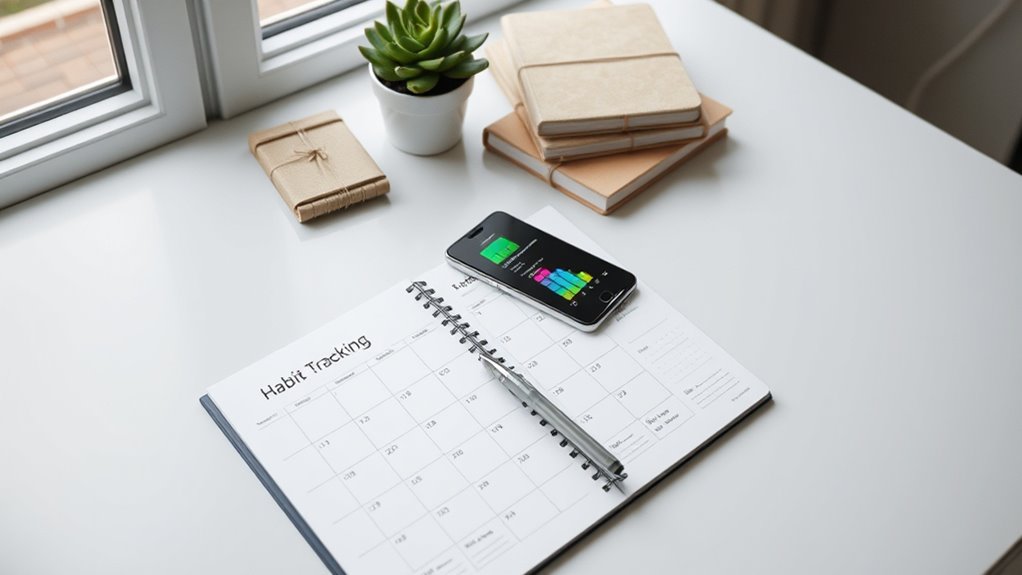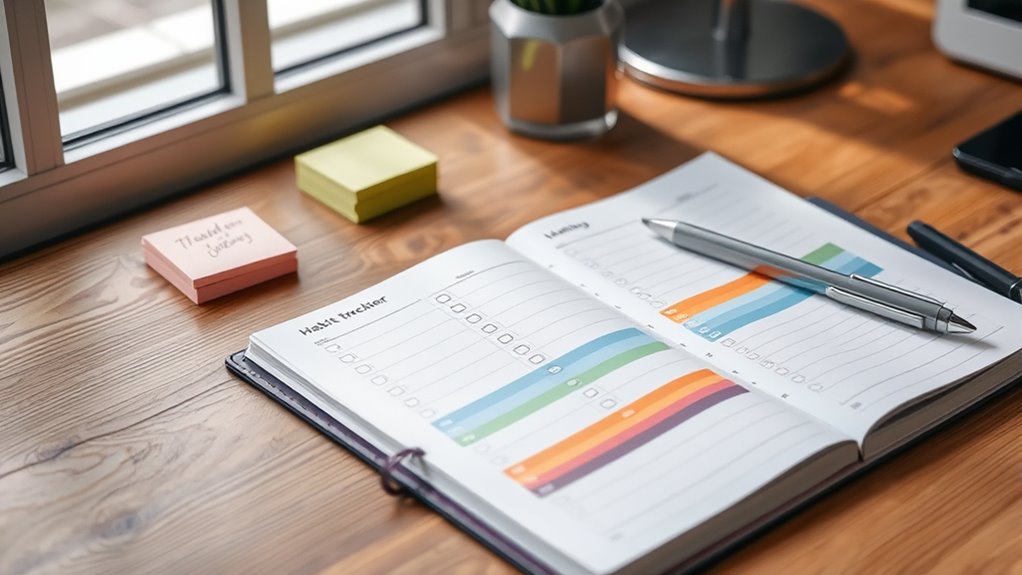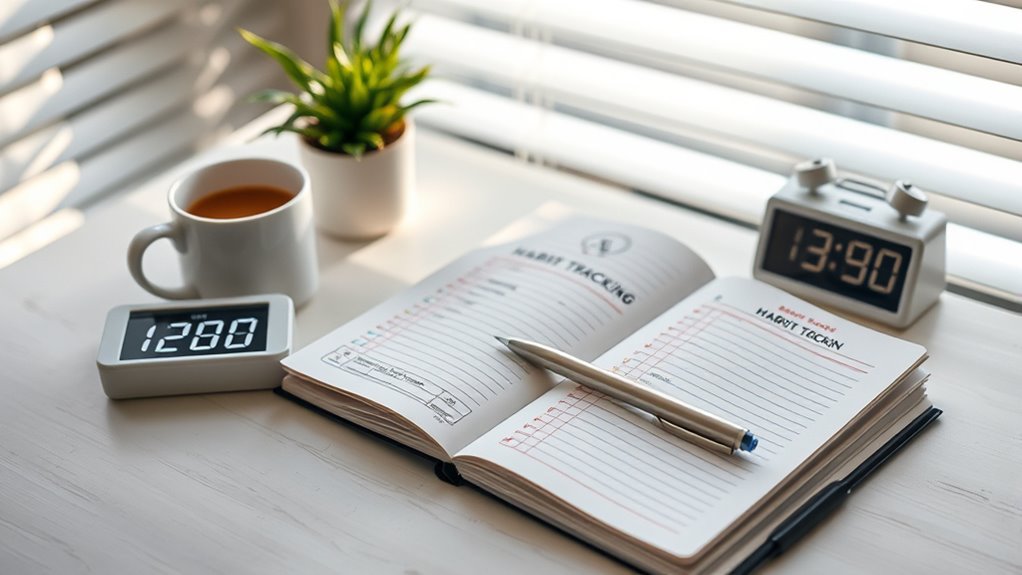For effective habit tracking, check in daily to stay consistent and motivated, review weekly to reflect on progress and make adjustments, and assess monthly to monitor long-term growth. Tailor the frequency based on each habit’s importance and your goals—some habits need daily attention, others weekly or monthly. Stay flexible and aware of signs you may need to tweak your routine. Keep exploring how to optimize your schedule for lasting success.
Key Takeaways
- Track daily for habits requiring reinforcement, like exercise or meditation, to build consistency.
- Review weekly to assess progress, celebrate wins, and adjust goals as needed.
- Conduct monthly assessments for long-term habits and overall progress tracking.
- Adjust tracking frequency based on habit type, motivation levels, and personal schedule.
- Incorporate spontaneous or flexible check-ins during busy or unpredictable periods to maintain consistency.
Daily Habit Check-Ins: Staying Consistent

To stay consistent with your habits, daily check-ins are essential. They give you regular motivation boosts, helping you stay focused and committed. When you review your progress every day, you reinforce your goals and build momentum. Consider enlisting accountability partners—friends, family, or colleagues—who can encourage you and hold you responsible. Sharing your daily wins and challenges keeps you motivated and provides a sense of accountability. These check-ins don’t need to be lengthy; even a quick reflection on what you accomplished or struggled with can make a big difference. By making daily habit check-ins a routine, you create a structure that supports consistency, ensuring you stay on track and maintain your habits over time. Incorporating simple plant care tips into your routine can also help reinforce positive habits and keep your space thriving.
Weekly Reviews: Finding Balance and Reflection

Weekly reviews offer a valuable opportunity to step back and assess your progress, helping you find balance amid daily routines. During this time, you can reflect on achievements and identify areas needing improvement. Think of it as a mental reset, fueled by motivation boosters like celebrating small wins or adjusting goals. Enlist accountability partners to provide honest feedback and encouragement. To make your review impactful, visualize these steps:
Use weekly reviews to reflect, celebrate progress, identify obstacles, and set actionable goals for continuous growth.
- Scan your habit tracker for patterns and trends.
- Celebrate successes, no matter how small.
- Pinpoint obstacles and plan solutions.
- Set actionable goals for the upcoming week.
- Remember that privacy policies help you understand how your data is collected and used, which can improve your experience and trust during these reviews.
This process keeps you motivated, grounded, and aligned with your long-term habits, ensuring continuous growth and balance.
Monthly Progress Assessments: Long-Term Tracking

Monthly progress assessments provide a big-picture view of your habits, helping you recognize patterns and measure long-term growth. By reviewing your tracking data, you can see which habits boost your motivation and which need adjustments. Sharing your progress with accountability partners keeps you motivated and accountable, reinforcing your commitment over time. These assessments encourage reflection on your habits’ consistency and effectiveness, giving you insight into your development. They also help you identify trends that might not be obvious in daily or weekly reviews. Regularly scheduling monthly check-ins ensures you stay focused on your goals and maintain habit motivation. Plus, involving accountability partners during these assessments keeps you honest and provides encouragement, making long-term progress more achievable. Incorporating habit tracking tools can further enhance your ability to monitor and adjust your routines effectively.
Adjusting Frequency Based on Habit Type

Since different habits require varying levels of attention, adjusting the frequency of your tracking guarantees you stay effective without becoming overwhelmed. For habits critical to your habit formation, like daily exercise, track daily to reinforce motivation techniques and build momentum. For less urgent habits, such as monthly decluttering, weekly or bi-weekly checks work better. Consider these examples:
- Daily habits like meditation or journaling—track every day to maintain motivation.
- Weekly goals like meal prep—review at the end of each week.
- Long-term habits like reading—assess monthly to gauge progress.
- Occasional habits like flossing—check sporadically, based on motivation levels.
- Also, incorporating habit tracking tools or apps can enhance consistency and accountability.
Adapting tracking frequency helps you stay focused and reinforces positive behavior without burnout.
Aligning Tracking Frequency With Your Goals
Aligning your tracking frequency with your goals guarantees your efforts stay purposeful and effective. If your motivation fluctuates, tracking more frequently can help you stay accountable and adjust quickly. For seasonal habits, less frequent tracking makes sense, allowing you to monitor changes over longer periods without feeling overwhelmed. For example, if you’re working on a summer fitness goal, weekly check-ins may suffice, while daily tracking might be better for daily meditation or journaling. Recognizing how your motivation ebbs and flows helps you choose a tracking schedule that keeps you engaged without burnout. Additionally, understanding electric bike costs can inform you about budgeting for related equipment if your habits involve active transportation. Ultimately, syncing your tracking rhythm with your goals ensures you maintain focus, celebrate progress, and adapt strategies as needed, making your habit journey sustainable and aligned with your personal rhythms.
Tools and Techniques for Effective Habit Monitoring
Choosing the right tools can make tracking your habits much easier. You might prefer digital apps or good old paper journals, depending on what keeps you motivated. Incorporating visual progress charts or setting reminders and alarms can also help you stay consistent and focused. Using data tracking and analytics can provide valuable insights into your habits and progress over time.
Digital vs. Paper Tracking
Have you ever wondered whether digital or paper tools make habit tracking more effective? Both options offer unique benefits. Digital journaling provides real-time updates, automatic reminders, and easy data analysis. Imagine your habits syncing seamlessly across devices, with notifications nudging you to stay on track. On the other hand, paper planners give you a tactile experience, making it easier to visualize progress at a glance. Picture flipping through colorful pages, jotting notes, and crossing off days with a pen. Consider these visualizations:
- Digital dashboards displaying streaks and trends
- Paper planners with handwritten checkmarks
- Reminders popping up on your device
- Handwritten reflections in a journal
Understanding the role of contrast ratio in image quality can also help you optimize your tracking environment by ensuring clear visibility of your progress, especially in dimly lit spaces.
Choose what suits your style to make habit tracking more effective.
Visual Progress Charts
Visual progress charts are powerful tools that help you monitor your habits at a glance and stay motivated. By visualizing your progress, you can easily see patterns and trends, which makes tracking more engaging and less tedious. These charts enhance progress visualization, allowing you to quickly assess how well you’re sticking to your habits and identify areas that need improvement. They also serve as motivation boosters, as seeing tangible results can inspire you to keep going. Whether you use bar graphs, line charts, or habit trackers, the visual element keeps your goals clear and accessible. Regularly updating your progress charts creates a visual feedback loop that reinforces your commitment and helps you stay focused on your habit-building journey. Incorporating visual feedback can further improve your tracking effectiveness by providing instant insights into your habit patterns.
Reminder & Alarm Systems
After creating visual progress charts to track your habits, setting up reminder and alarm systems can further guarantee you stay on course. Imagine hearing a gentle chime in the morning, prompting you to practice a habit stacked with motivational quotes to boost your mindset. Or visualizing your phone alert flashing at midday, reminding you to complete your daily goal. You might also set a recurring alarm that signals it’s time for a quick habit check-in, reinforcing consistency. Lastly, consider using app notifications that display your favorite motivational quote, inspiring you to keep progressing. These tools help integrate habit stacking seamlessly into your day, making habit tracking automatic and less burdensome. Effective communication and strategic reminders, reinforce your habits and stay motivated to reach your goals.
Signs You Might Need to Change Your Schedule

If you find yourself consistently feeling exhausted or unmotivated, it’s a clear sign that your current schedule might not be working for you. Maybe your habits feel forced, or you struggle to stay consistent despite motivational quotes. Habit stacking can help, but only if your routine aligns with your energy levels. Consider these signs: sound design techniques can be applied to create engaging routines that suit your natural rhythms.
| Sign | What to Do |
|---|---|
| Lack of progress | Reassess your schedule and adjust timing |
| Feeling overwhelmed or stressed | Simplify habits or change their order |
| Frequent missed days | Break habits into smaller steps |
| Low motivation or burnout | Incorporate more flexibility |
If these resonate, it’s time to tweak your schedule for better results.
Creating a Flexible Habit Tracking Routine
You need a habit tracking routine that works for your life, not against it. By adjusting how often you check in, you stay flexible and stay on track, even when your schedule changes. Remember, it’s all about finding the right balance that fits your lifestyle. Incorporating consistent review intervals can help you monitor your progress without feeling overwhelmed.
Adaptable Tracking Frequency
Creating a flexible habit tracking routine means tailoring your tracking frequency to fit your lifestyle and goals. This approach helps maintain motivation and sustains habit streaks, even during motivation dips. To do this, consider varying your tracking schedule based on your progress and energy levels. For example:
- Track daily during high-motivation weeks to build momentum.
- Switch to every other day when motivation dips to prevent burnout.
- Use weekly check-ins to reflect and adjust your goals.
- Incorporate spontaneous tracking days when life gets busy or unpredictable.
- Incorporate somatic practices to stay connected with your body and emotional state, enhancing your overall habit formation process.
This adaptability keeps your routine fresh, prevents burnout, and ensures you stay consistent. By customizing your tracking frequency, you make habit formation more manageable and less rigid, encouraging long-term success.
Adjusting for Lifestyle Changes
When your lifestyle shifts—such as changing jobs, adjusting your daily routine, or experiencing personal obligations—it’s essential to adapt your habit tracking approach accordingly. Motivation fluctuation can occur during these times, making it harder to stay consistent. To stay on track, consider seasonal adjustments that align with your current schedule and energy levels. For example, during busy seasons, simplify your habits or reduce tracking frequency to prevent burnout. Flexibility allows you to maintain progress without feeling overwhelmed. Regularly reassess your routines and modify your tracking methods as needed, ensuring they support your evolving lifestyle. Incorporating time zone awareness can also help you coordinate your habits with your new schedule, especially if it involves different locations or travel. This adaptive approach keeps your motivation stable and helps you develop habits that genuinely fit your new circumstances.
Frequently Asked Questions
Can Tracking Habits Too Frequently Hinder Progress?
Yes, tracking habits too frequently can hinder progress. It might overwhelm your tracking motivation and cause you to focus on minor setbacks rather than overall growth. Over-monitoring can disrupt habit consistency by making you overly fixated on perfection. To stay effective, find a balance—track regularly enough to monitor progress without becoming obsessive. This way, you maintain motivation and support steady habit development.
How Do I Know if I Need to Increase or Decrease Tracking?
You should increase or decrease tracking based on your motivation fluctuations and habit complexity. If you notice your motivation wanes or your habits become more intricate, consider tracking more frequently to stay engaged. Conversely, if tracking feels overwhelming or your motivation drops, scale back to avoid burnout. Listen to your feelings and adjust accordingly, ensuring tracking supports your progress without becoming a source of stress or frustration.
What Habits Benefit From Less Frequent Monitoring?
Certain habits, like those involving habit variations or ones that already deliver motivational boosts, benefit from less frequent monitoring. You can track these weekly or even bi-weekly to maintain motivation without feeling overwhelmed. This approach keeps your focus on progress rather than daily fluctuations, helping you stay consistent. Less frequent checks allow you to enjoy the motivational boosts and adapt habit variations more naturally, reinforcing your long-term commitment.
Is There an Ideal Time of Day for Habit Check-Ins?
Think of habit check-ins like planting seeds—timing matters. For best results, you should pick a consistent time that fits your daily routines, such as morning coffee or evening wind-down. This consistency helps reinforce habits. For example, if you review your progress after breakfast, it becomes part of your routine, making it easier to stay committed. Timing considerations make habit tracking more effective and integrate seamlessly into your day.
How Do I Prevent Burnout From Constant Habit Tracking?
To prevent burnout from constant habit tracking, give yourself motivational boosts by celebrating small wins and taking breaks when needed. Use tracking tools that are simple and user-friendly, so tracking feels rewarding rather than overwhelming. Schedule regular intervals to review progress without obsessing, and remember, it’s okay to skip a day or two. This balance keeps you motivated and prevents burnout while still maintaining positive habits.
Conclusion
By balancing your habit check-ins, you build better momentum, maintain meaningful motivation, and master lasting change. Stay consistent, stay curious, and adapt your approach as needed. Remember, regular review and reflection reinforce resilience and results. With a flexible, focused routine, you’ll foster growth, guard against burnout, and grow your habits into powerful practices that propel you forward. Embrace the journey, and watch your habits naturally flourish with purposeful persistence.









